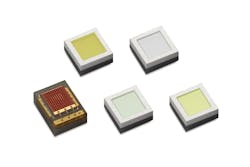Lumileds has announced the Luxeon Rubix family of color LEDs with both a tiny form factor and high drive-current capabilities. The monochromatic red, green, blue, and royal blue LEDs along with a phosphor-converted white LED target dynamic color lighting in applications from entertainment to industrial to automotive in nature, with the compact form opening up new possibilities for the use of dynamic color solid-state lighting (SSL).
Lumileds has long been one of the few LED manufacturers with a significant emphasis on a color LED portfolio, as we covered in a foundational article on color LEDs and applications a few years back. Now the company hopes to open the door to even more applications via the 1414 (1.4×1.4-mm) package. That tiny footprint could deliver better color mixing and significantly reduces the footprint of an RGB (red, green, blue) or RGBW (red, green, blue plus white) pixel in an array.
The new LEDs could enable smaller projection-type products that illuminate building surfaces, landmarks, bridges, and more. Lumileds said it also has demand for the smaller LEDs in machine-vision applications and in work lights. And the LEDs will serve in emergency vehicle lighting applications.
“Luxeon Rubix introduces a size and power ratio that has never before existed for color LEDs,” said LP Liew, product marketing manager at Lumileds. “Think of Luxeon Rubix as pixel-like — uniquely shaped arrays are possible, optics can be smaller, and exceptionally high light density allows solutions across a broad range of lighting segments to take new forms and increase their value.”
The monochromatic Rubix family members radiate at 620–630 nm (red), 520–535 nm (green), 465–485 nm (blue), 440–455 nm (royal blue). Typical flux output at 1.5A of drive current is 85 lm for red, 310 lm for green, and 112 lm for blue. Those values look very inconsistent, but remember that the lumen is tied to human visual sensitivity that drops considerably in the blue and red region. Indeed, Lumileds simply quotes radiometric output of 1635 mW for the royal blue LED.
The white LED in the family delivers 5700K CCT, a value that might not be popular in general lighting but that works well in RGBW color applications. The LED typically delivers 440 lm with efficacy of 93 lm/W. All of the LEDs can be overdriven to 3A, trading off brightness versus energy efficiency.
Lumileds also stresses the fact that all members of the family are constructed similarly, measure the same height to the light-emitting surface, and therefore have identical focal lengths. We have heard this story from Lumileds before, and in fact that is a primary reason there is a white Rubix LED family member as opposed to just mixing in another Lumileds white LED. The consistent focal length results in tight beam control and uniform color mixing.
Lumileds has also applied its typical practice of hot binning to the color LED family. The LEDs are tested and binned at 85°C. These latest LEDs significantly push performance forward and those architectural, epitaxial, and package improvements enabled the company to move to a smaller emitter.
It will be interesting to see what innovative applications SSL developers come up with after being handed such tiny emitters that can be driven at levels more common in components double or triple the size. We may see dynamic color in unexpected applications that span the range of benefits from entertainment to precision in the factory.
For up-to-the-minute LED and SSL updates, why not follow us on Twitter? You’ll find curated content and commentary, as well as information on industry events, webcasts, and surveys on our LinkedIn Company Page and our Facebook page.





